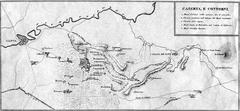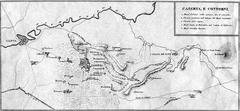
Casertavecchia Visiting Hours, Tickets, and Guide to Caserta Historical Sites
Date: 04/07/2025
Introduction
Casertavecchia, a mesmerizing medieval village perched atop Monte Virgo near modern Caserta in Italy’s Campania region, invites travelers into a world where centuries-old architecture and vibrant local traditions coexist. With origins reaching back to at least the 9th century, and archaeological evidence suggesting even earlier Roman settlements, Casertavecchia’s strategic position made it a historic stronghold and religious center—most notably during the Norman period. Today, the village’s winding cobbled streets, stone houses, and remarkable monuments, such as the Cathedral of St. Michael the Archangel, offer an immersive journey through southern Italy’s layered past (visitcampania.info; PG World{:target=“_blank” rel=“noopener noreferrer”}).
As an Italian National Monument, Casertavecchia is not only a preserved relic but also a vibrant cultural hub, hosting annual festivals, artisanal markets, and culinary events. With its accessibility from Caserta city, practical visitor information, and a wealth of nearby attractions, it stands as an essential destination for anyone exploring Italy’s storied heritage (aroundtheworldwithme.com). This guide provides detailed information on visiting hours, ticketing, historical highlights, cultural events, and travel tips to help you make the most of your visit.
Table of Contents
- Historical Overview and Visitor Guide
- Practical Visitor Information
- Must-See Sites and Attractions
- Cultural Events and Living Heritage
- Gastronomy and Local Products
- Nearby Attractions
- Frequently Asked Questions (FAQ)
- Visual and Media Resources
- Conclusion and Call to Action
- References and Official Links
Historical Overview and Visitor Guide
Early Origins and Lombard Foundations
Casertavecchia’s documented history begins in the 9th century as “Casa Hirta,” referenced in the Historia Langobardorum Beneventanorum (visitcampania.info). Archaeological finds indicate even earlier Roman influences, with the site likely serving as a rural administrative center. Its hilltop location made it a natural defensive outpost, which the Lombards fortified further as part of their southern Italian dominions.
Norman Conquest and Medieval Flourishing
The Norman arrival in the 11th century ushered in Casertavecchia’s golden age. The construction of the Cathedral of St. Michael the Archangel, between 1113 and 1153, became a defining symbol of the village’s religious and administrative prominence (just.edu.jo; academia.edu). The village’s layout, with its defensive walls and winding alleys, largely dates from this era and remains remarkably intact (visitcampania.info).
Architectural Features and Urban Fabric
Casertavecchia is a living showcase of medieval architecture:
- Cathedral of St. Michael the Archangel: A Romanesque masterpiece with Arab-Norman and Byzantine influences, characterized by its three-aisled nave, ornate capitals, and a striking bell tower (just.edu.jo).
- Norman Castle: Remnants of the original fortress, offering panoramic views of the Campanian plain.
- Medieval Streets and Piazzas: Narrow alleys, stone arches, and small squares such as Piazza Vescovado.
- Chapel of San Rocco & House of Mullioned Lights: Examples of religious and domestic medieval architecture (visitcampania.info).
Decline and Transformation
Casertavecchia’s fortunes waned in the 15th century with the rise of the Aragonese and later the Bourbons, particularly following the construction of the Royal Palace of Caserta. The bishopric’s transfer to the valley and depopulation followed, leaving the village in gradual decline (visitcampania.info).
Modern Rediscovery and Preservation
In the 20th century, Casertavecchia gained recognition as a National Monument, prompting significant restoration efforts and cultural revitalization. Festivals, artistic events, and sustainable tourism initiatives now help preserve both the physical fabric and living traditions of the village (visitcampania.info).
Practical Visitor Information
Visiting Hours and Tickets
- Village: Open year-round, accessible at all times.
- Cathedral of St. Michael the Archangel: Daily, 9:00 AM–6:00 PM. Hours may adapt for religious services or special events.
- Norman Castle: Open daily, typically 8:30 AM–7:00 PM.
- Church of the Annunziata: 10:00 AM–5:00 PM.
- Entry Fees: Village access is free. Cathedral and castle entry are usually free; guided tours cost €3–€20 (reggiadicaserta.cultura.gov.it). Donations are welcome.
Getting There and Accessibility
- Transport: About 10 km (20 mins by car) from Caserta; limited public bus service. Car or guided tour is recommended (PG World{:target=“_blank” rel=“noopener noreferrer”}).
- Parking: Located near village entrance.
- Accessibility: The terrain is steep and cobbled, limiting access for visitors with mobility impairments. Some assistance may be required for accessing the cathedral and main piazza.
Guided Tours and Tips
- Guided Tours: Highly recommended for historical context and hidden stories. Local guides can be booked online or at visitor centers.
- Best Time to Visit: Spring (April–June) and autumn (September–October) offer mild weather and vibrant events.
- Safety & Etiquette: Casertavecchia is safe and welcoming. Modest attire is required in churches; respect the quiet atmosphere, especially during religious observances.
Must-See Sites and Attractions
- Cathedral of San Michele Arcangelo: The village’s spiritual and architectural highlight, boasting Romanesque design, fine frescoes, and an ancient crypt.
- Norman Castle: Offers evocative ruins and spectacular views.
- Medieval Streets & Piazzas: Ideal for strolls, local crafts, and photography.
- Church of the Annunziata: Notable for its 14th-century architecture and frescoes.
- Bishop’s Palace: A symbol of ecclesiastical authority, viewable from the exterior.
- Artisan Shops & Trattorias: Experience authentic Campanian cuisine and purchase local ceramics or lacework.
Cultural Events and Living Heritage
- Feast of San Michele Arcangelo: Late September, with processions, communal meals, music, and fireworks (reggiadicaserta.cultura.gov.it).
- Medieval Festival: Late summer/early autumn, featuring reenactments, artisan markets, and performances (tartarugainviaggio.it).
- Art Exhibitions & Concerts: Held in the cathedral, castle, or piazza, especially during summer months (aroundtheworldwithme.com).
Local traditions, religious observances, and culinary festivals keep the spirit of Casertavecchia alive for both residents and visitors.
Gastronomy and Local Products
- Mozzarella di Bufala Campana: World-renowned cheese produced regionally.
- Handmade Pasta & Game: Dishes such as scialatielli, gnocchi, and pappardelle with wild boar.
- Olive Oil & Wine: Sourced from surrounding hills.
- Artisanal Sweets & Pastries: Often flavored with citrus or almonds.
Dine in family-run trattorias to savor authentic flavors and engage with the local community (blog.italotreno.com).
Nearby Attractions
- Royal Palace of Caserta: UNESCO World Heritage site, renowned for its Baroque architecture and vast gardens (reggiadicaserta.beniculturali.it).
- San Leucio Complex: Former royal silk factory and village, with museum and gardens.
- Natural Parks & Hiking Trails: The Campanian countryside offers scenic walking routes and panoramic viewpoints.
Frequently Asked Questions (FAQ)
Q: What are Casertavecchia’s visiting hours?
A: The village is open year-round. Main sites (cathedral, castle) are typically open 9:00 AM–6:00 PM, but hours may vary seasonally or during special events.
Q: Do I need tickets to visit?
A: Entry to the village and most sites is free. Guided tours may require tickets (€3–€20), available onsite or online.
Q: How do I get to Casertavecchia?
A: By car (20 mins from Caserta) or limited bus service. Parking is available at the village entrance.
Q: Is Casertavecchia accessible for people with disabilities?
A: Accessibility is limited due to cobbled, steep streets. Main piazza and cathedral are reachable with assistance.
Q: When are the major festivals?
A: The Feast of San Michele Arcangelo is held in late September; the Medieval Festival occurs in late summer or early autumn.
Visual and Media Resources
- Images: High-quality photos of the cathedral, castle, panoramic viewpoints, and festival scenes are recommended. Include descriptive alt text (e.g., “Casertavecchia Cathedral Romanesque façade”).
- Interactive Map: Highlight key attractions, routes, and parking areas.
- Virtual Tours: Available via the official Caserta cultural heritage website (reggiadicaserta.cultura.gov.it).
Conclusion and Call to Action
Casertavecchia is a captivating blend of history, architecture, and living tradition. Its medieval streets, iconic cathedral, and vibrant festivals offer an immersive experience into the heart of Campania’s heritage. To stay updated on visiting hours, events, and travel advisories, consult official tourism websites and consider using the Audiala app for guided tours and local insights. Plan your journey today and uncover the timeless allure of this hilltop treasure!
References and Official Links
- Casertavecchia Historical Overview and Visitor Guide (visitcampania.info)
- Visiting Casertavecchia: Hours, Tickets, and Exploring Caserta’s Historic Hilltop Village (PG World)
- Casertavecchia Visiting Hours, Tickets, and Must-See Historical Sites (Places and Things To Do)
- Discover Casertavecchia: Visiting Hours, Tickets, and Cultural Events in Caserta’s Historical Village (Around the World With Me)
- Cultural Events in Casertavecchia (reggiadicaserta.cultura.gov.it)
Internal Links:




